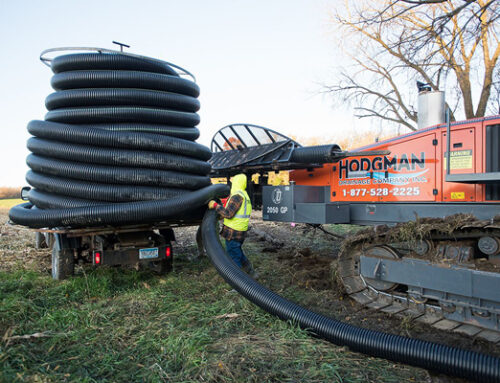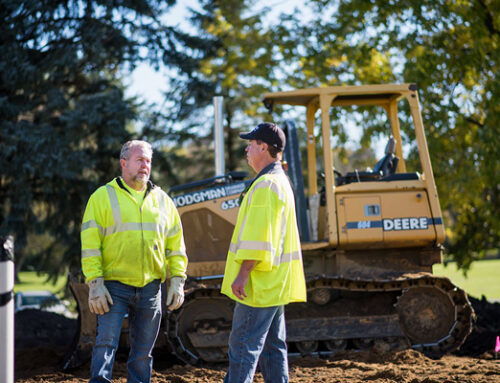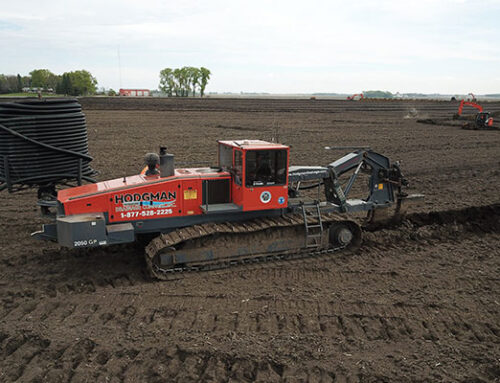Key Takeaways:
- Field tiling is the practice of installing specialized subterranean drain pipes in agricultural fields to assist with wet soil drainage.
- Minnesota has well-drained, fertile loamy soil, but it also has glacial-fed wetlands that can affect the drainage rate of agricultural fields in the vicinity.
- While tiling provides a sustainable solution to bring down the water table in waterlogged soils, it is still not widely understood by people, thus resulting in many misconceptions.
- Compromised water quality, increased soil erosion, higher levels of leeched nitrates, and unregulated practices are just a few of the misconceptions regarding tiling.
- Tiling, when done by a professional drainage company, results in a myriad of benefits, including, but not limited to, enhanced soil fertility, nutrient recycling, & increased farming seasons.
Minnesota’s Lester loam is among the region’s most well-drained & naturally fertile soils. So, you might wonder why farmers there are gearing up on field tiling. Isn’t it a practice used to manage waterlogged or swampy soils?
The answer is simple; soils need to be of a certain quality for agricultural purposes without over-relying on chemical fertilizers or artificial irrigation. Not that the soil has any problem, but Minnesota has a variety of well-drained lands, wetlands & swamps too. These are hydric soils that are not ideal for farming despite their fertility. Tiling provides a controlled rate of drainage that helps in several ways:
- It helps to prevent isolated wet ditches in farm fields.
- It helps restore oxygen to the soil & kickstart nutrient-generating decay.
- It reduces soil salinity by limiting moisture evaporation in the topsoil.
- Excess water in post-rain soil with limited drainage can lead to rotten vegetation instead of decay. Tiling keeps the soil drained and allows for natural plant decay.
The problem is a lack of awareness about the merits of installing field tiling. Poor water quality from runoff is often attributed to tiling when in reality, it is the outcome of poor farming & fertilizer application practices. Although Minnesota has its own ‘Drainage Code‘ to manage wet soils, many folks have reservations about tiling.
Hodgman Drainage Company, Inc. has a few invalid myths to share with you to help dispel your fears as an aspiring agricultural professional. That way, you can fully actualize your yield potential through the conservation practice of tiling.
Myth 1: Tiling Leads to Uncontrolled Surface Runoff | Field Tiling
Surface runoff is the natural water drainage over the soil’s surface. Compared to this runoff, field tiling ensures gradual runoff. The maximum capacity of land drainage with a tiling system is around an inch of water drained per day. Though many have concerns regarding waterlogged storm ditches and post-rain streams, the research supports that a tiling system is a minor contributor to runoff in high-flow periods.
Surface runoff is uncontrolled, especially after heavy rains, when there is no system of drainage or channeling to hinder soil erosion. In comparison, tiling provides a wide capability of accumulating water & has fewer inlets at strategic gather-points to break down the speed of the runoff.
That’s one myth busted, thanks to modern tiling systems!
Myth 2: No Authority Regulates Tiling
This misconception revolves around the idea that field tiling somehow hinders water drainage into open reservoirs in areas experiencing sanitation issues or a drought. In fact, field tiling preserves the soil’s nutrients while replenishing the reservoirs nearby for livestock or urban & rural needs.
Tiling is among the most regulated practices in agriculture & farming. Regulatory authorities have extended rules for state, federal & local ordinances concerning land drainage.
Some projects require permits, while others are state inspected for approval or denial. Adequate tiling systems are in such need that as many as seven regulators might review the viability of a proposed project to ensure compliance with drainage ordnances.
Myth 3: Tiling Taints Ground Water
While not entirely false, it is just a matter of tradeoffs. Excessive use of pesticides and poor applications of nitrogen compounds to enhance soil fertility do taint groundwater & surface runoff. Field tiling is installed with the intent of reducing runoff & sediment movement to retain the soil’s natural nutrients. Still, any agricultural chemicals leeched into the soil will show up in the tile drainage.
Determining how much tiling affects water quality lies in understanding how much sediment & phosphates are reduced in the drainage compared to nitrates. Typically, the tradeoff is positive, considering that farmers need a good harvest to keep the food market running. Furthermore, farmers are adapting to sophisticated nitrogen applications to limit its adverse leeching.
So, tiling is not really a player in exacerbating tainted groundwater; it is simply a matter of good framing practices.
Myth 4: Field Tiling Affects Soil Fertility
We must understand what constitutes good soil and how natural & man-made actions affect that balance. Healthy soil contains moisture, oxygen, and microorganisms that break down organic matter into nutrients.
When soils become too waterlogged from a rise in the water table, heavy rains, or human intervention, the microorganisms in the soil are starved of oxygen and die off. That affects the rate at which a soil’s nutrients are cycled back. A lack of nutrients will affect crop yields, reducing nutrients’ return to the soil via natural decay.
Tiling assists with draining soils that would otherwise take too long to drain to offer a healthy ratio of water & oxygen. All this begins with proper water management for crop irrigation, proper use of phosphate & nitrates, and then installing appropriate drainage to boost yields in a sustained manner.
Myth 5: Tiling Does Not Conserve the Land | Field Tiling
Conservation means leaving a tract of the land untouched for habitat reasons, much like wildlife parks & reservations – an environmental concern already in effect. But people need to eat, and farmers need land & fertile soil to farm & raise livestock to supply sustenance for urban & rural needs. So, when deciding to develop a tract of land for farming, it is in everyone’s best interests to do it sustainably. That way, less acreage is required for crop production, and more can be allotted for conservation purposes.
Field tiling is a 100% sustainable practice that helps conserve soil quality, control surface runoff, reduce sediment erosion, and replenish water reservoirs. Today’s technology considers not only the crop but the natural flora & fauna around it. Tiling is designed considering field counters & uniform drainage so surrounding habitats are not affected negatively.
The benefits of tiling far surpass the purported demerits, allowing more farmers to upgrade their field drainage, improve their soil quality & extend their crop-growing seasons – all without damaging the natural environment!
The Right Drainage Company Ensures Your Soil Thrives!
Hodgman Drainage Company, Inc. serves farmers & agricultural enterprises in and around West Concord, MN, with specialized soil drainage systems & site development solutions at small & ambitious scales. Our practices are state-compliant & our technology delivers sustainable solutions to enhance your crop yield & boost soil quality without chemical means. We’ve been around since the early 80s, so your land is in good hands!
Feel free to call us at 507-528-2225 for more details. Thank you for considering our services!



